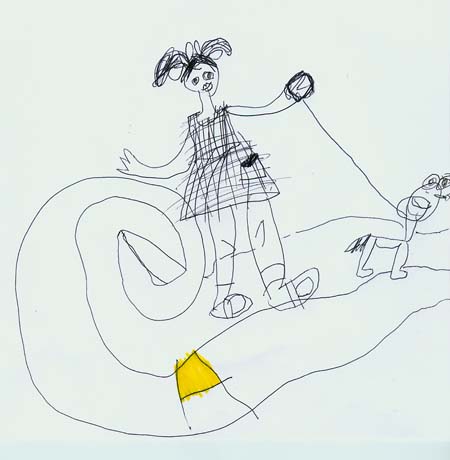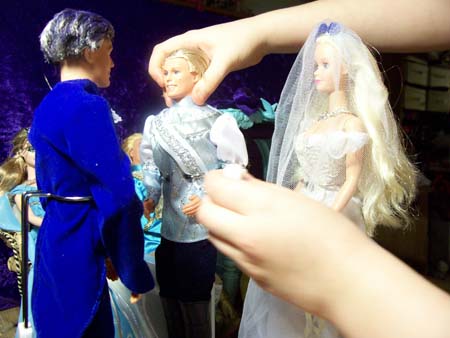Encouraging Creativity
Part of an intermittent series of musing on the odd objections people make to home schooling

by Robyn Coburn

by Robyn Coburn
So how do you encourage creativity?
People often seem to be looking for ideas to encourage or teach creativity. They assume it must be taught as a concept, and apparently it is pretty scary. I’ve always thought it a bizarre question. Anyone observing even briefly in our home would surely dismiss the idea that creative thinking would be lacking were it not purposefully encouraged. I never feel any need to encourage creativity. I just try to keep up!
Every day Jayn engages in a multitude of traditionally creative activities. She draws using a wide variety of media including pencils, crayons, markers of various types, and even ink with a selection of homemade quills. Her subject matter includes dress designs for herself or her dolls, ideas for diorama backgrounds, renderings of characters from movies, or illustrations of stories she has made up herself. Her art is a commentary on her daily life, reactions, and emotional state.
She builds sculptures and puts together installations. One of her ongoing creations is called “Crystaltopia,” a magical land where sometimes fairies, sometimes mermaids dwell surrounded by strange found or manufactured objects. It lives atop a small chest and is framed by a rich ornament of bead strings, lace, and hanging jewels.
Jayn loves working with paper—making stickers, layering, collage, paper dolls, and exploring the malleable qualities of folded and cut paper. She works with cloth, wire, beads of all kinds. We do polymer clay and air dry clay sculptures. She has future plans for working in resin and wax casting. Jayn can turn a paper napkin into a baby doll with a cotton ball, sticky tape, and a scrap of lace.
Nor is her imaginative visualization limited to traditionally artistic arenas. Jayn once decided to reorganize all the counters in our skimpy kitchen. Her space planning and efficiency put my prior efforts—a professional in the field of design—to shame. She was able to look at the proposed floor plan of her new room and swiftly rearrange the furniture cutouts in a way that was more effective than my initial idea and employed the classic interior design techniques of defining space by usage and flow patterns.
I remember the first time I watched six-month-old Jayn solve a problem creatively using logic. I had placed a variety of cards around her field of vision on her blanket on the ground as she lay on her belly. One card was partially hidden behind a teddy bear. She gazed for a while. Then she slowly stretched her arm out, picked up the offending bear, and placed it aside. She then reached to the limit of her fingertips to grasp the desired card. Two weeks later she worked out that she could get the donut rings off their stander by tilting it. All the encouragement she needed was the tools and no one doing it for her.
Apparently something happens between infancy when parents notice a vividly obvious plethora of creative thinking and the removal to schools some five or six years later when creativity becomes something requiring encouragement. But first it has to be identified, quantified, and categorized.
The California State education standards are published here and are probably similar to other state codes. The language and enormous length of the requirements and expectations can be intimidating—so I personally ignore them. I have that luxury here in California with no reporting.
Lofty goals and pompous language about integrating arts into a well rounded education are expressed in the Introduction to the Visual and Performing Arts Content Standards: “As they study and create in the arts, students use the potential of the human mind to its full and unique capacity.” However the way the curriculum is then structured and expressed only promotes disconnection of the various art forms from each other and from the rest of the school experience. The arts curriculum seems represented as in service to the main academic skills areas, a kind of “do art because it gives you problem solving skills for your future employment in a high tech world.” It feels like an uncomfortable dichotomy.
By contrast at our house, arts practice and undirected imaginative expression are the highly valued foundations of our daily life. Not coincidentally, both James and I have been employed in creative arts fields that employ high technology for most of our working lives.
The heading for Visual Arts in each elementary grade is as follows:
ARTISTIC PERCEPTIONWell there’s my first issue right there—“Unique to the Visual Arts.”
Processing, Analyzing, and Responding to Sensory Information Through the Language and Skills Unique to the Visual Arts Students perceive and respond to works of art, objects in nature, events, and the environment. They also use the vocabulary of the visual arts to express their observations.
When I returned to college, I was fortunate to attend a unique school. It was predicated on the Bauhaus principle that all the arts were considered connected and that the greatest artists were those whose practices and thinking encompassed many media, art forms, and other fields such as the sciences. The spiritual father of the school was ultimate Renaissance thinker, scientist, and artist, Leonardo da Vinci. All students were expected to take subjects outside of their main vocational discipline and encouraged to venture into other faculties of the University as well. All students from each year met once a week for “Theory,” a wide ranging art history and philosophy lecture/discussion with the key concepts being “cross fertilization” and “multi-disciplinary practice.”
It was a lot of fun, and there were many mature age undergrads there like myself who had worked or studied in some other field entirely but had been irresistibly drawn to the creative arts, like the radiographer who was now an actor and painter. The majority of the students embraced the multi-arts philosophy and relished the opportunity to have access to both the studio facilities and the community. I recall the classical ballet dancer who longed to direct avant-garde theater, a printmaker who embraced costuming via the textiles department, musicians who loved filmmaking, and sculptors excited about collaborating with scenic designers.
Maybe thriving at this university gave me an enhanced appreciation of blurred edges. I find the concept of interconnectedness of all knowledge, one of the tent poles of Unschooling philosophy, to be a no-brainer. Art as science as history as math as language studies as economics; skills acquisition as a function of activity rather than a separated prerequisite. I believe creativity is the foundation of all activity.

Jayn seems perfectly satisfied with her own abilities and seems to prefer self-instigated practice to any kind of instruction or suggestion. Well meaning relatives have given her stencil rubbing devices, the kind which enable one to draw an exact replica of a licensed character. She usually explores them briefly straight out of the box before putting them on the shelf to gather dust.
My concerns about the idea of art classes are manifold, especially since Jayn has never asked for any such thing. My first niggling fear is that Jayn might get the idea that she has been doing it wrongly up until now. She would probably react very assertively to being told what to draw, let alone how to draw. I’m told that students should do still-life renderings of round fruits in a grouping to learn how to see and reproduce volume, but Jayn has never been remotely interested in this type of impersonal subject. Evidently it is part of a sequence of artistic development, and it is thought that a professional can lead or direct that development so much better than a parent.
Meanwhile Jayn, forging her own path, has already created works in a cubist multi-perspective style, depicted movement reminiscent of the Futurists, and deduced the existence of perspective, with distant objects being smaller in the landscape, all through her own discoveries. I can just hear her saying, “No I think I’ll draw x instead” and consternation ensuing.
I have noticed that Jayn will generally correctly extrapolate the method of completion of any kind of crafty task from just examining the finished object or seeing the beginning of the construction process. The few times that she has looked into how-to books, she has become frustrated, preferring her own fluid process to the classical step-by-step approach. She has no patience with waiting for the group to move on to the next step either.
Finally the story making process that is intertwined with all of her visual arts activity requires an attentive and focused listener. I suspect that she would be pegged as disruptive if she chose one of her colleagues as the recipient of her story, or excessively needy if she wanted to monopolize the teacher.
Just as Jayn has always sought information by making statements about her ideas rather than asking direct questions, she prefers to make her own first attempt and then query if it seems to be working. One example is cooking—and goodness knows this is not one of my strong suits. Jayn has suddenly decided that she wants to cook dinner every night and make other food during the day. Yesterday she made perfectly grilled cheese sandwiches for her guest entirely by herself—she even turned on the stove alone, having asked me the day before about the correct level for this work. She has made Veal Scaloppini with limited and somewhat resented supervision, used the microwave for frozen vegetables, and produced two surprise desserts entirely unaided with the exception of getting me to reach down some ingredients from the high cupboard and put up her stepladder. It has been a delight to share this new interest with her.
Which brings me to the main reason that I doubt I will seek out an art class for Jayn in the near future. It is one of the same reasons that her father and I reject school. Why should some other person receive all that is her best? Why should some stranger be the person to see her sparkle and be the one to participate in her enthusiasm, her sudden explosive “wow” moments? On the flip side I’m sure I don’t want to subject an instructor or the rest of a group class to Jayn’s frustrated outbursts or downright hostility if anyone tries to assist or worse correct her before she asked for help.

So how do I encourage her creativity? I provide the multitudes of raw materials. I refrain from offering unsolicited advice. Possibly the hardest thing of all, I avoid trying to rescue her from the frustrations of making mistakes and a certain amount of wheel reinvention. I listen to her big plans for the future and her ideas and her expositions and narratives. I exult in her dances. I clear a space on the table and happily tidy up all the messes afterward. I assume that everything she does has a creative, imaginative, wonderful thought process behind it. Then I get the heck out of her way.
In October 2011, I wrote and asked Robyn the name of the university she was describing above. It's the University of Wollongong, in New South Wales, and Robyn earned a Bachelor of Creative Arts degree with honors. —Sandra the editor


